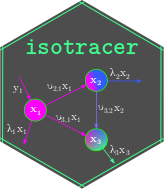

Isotope tracer addition experiments are used to answer a wide variety of biological, ecological and evolutionary questions. In these experiments, a labeled element is injected into a biological system and its fate is traced throughout the system to estimate the flux of matter across compartments. Tracer additions can be used across all levels of biological organization from cells and tissues, to organisms and ecosystems. The isotracer package provides tools to analyze data from such experiments.
The recommended way to install the package is to get it from CRAN:
install.packages("isotracer")The documentation for the latest stable version is available online. Start with the Quick Start tutorial!
Use citation("isotracer") to check how to cite isotracer:
López-Sepulcre A, Bruneaux M, Collins SM, El-Sabaawi R, Flecker AS, Thomas SA (2020). “A new method to reconstruct quantitative food webs and nutrient flows from isotope tracer addition experiments.” The American Naturalist, 195(6), 964-985. doi: 10.1086/708546 (URL: https://doi.org/10.1086/708546).
Bruneaux M, López-Sepulcre A (2021). “isotracer: an R package for the analysis of tracer addition experiments.” doi: 10.1101/2021.08.09.455668 (URL: https://doi.org/10.1101/2021.08.09.455668), (Preprint uploaded to the bioRxiv server).
You can install the latest stable version, which might be a bit more recent than the version currently on CRAN, directly from GitLab:
devtools::install_gitlab("matthieu-bruneaux/isotracer", quiet = TRUE)Alternatively you can try the latest development version, but note that it might contain some maturing features with a changing interface and possibly some bugs!
devtools::install_gitlab("matthieu-bruneaux/isotracer@develop", quiet = TRUE)The documentation for the development version is available online.